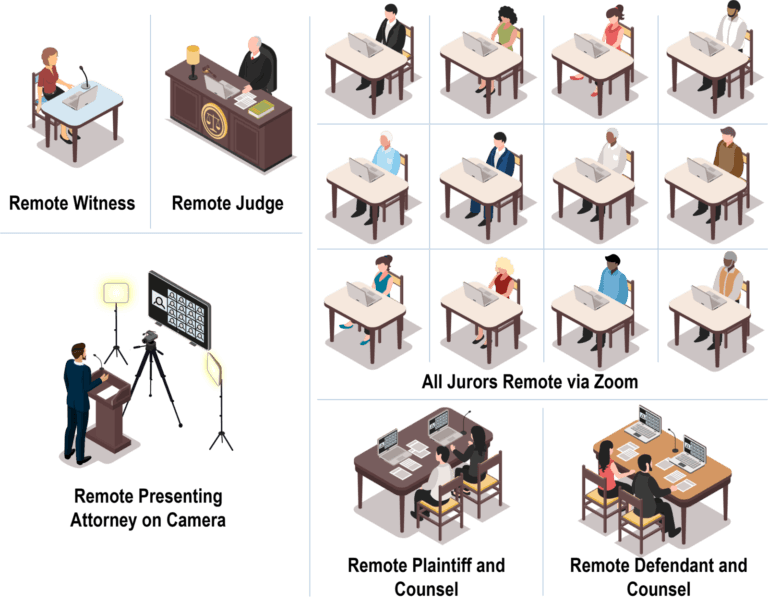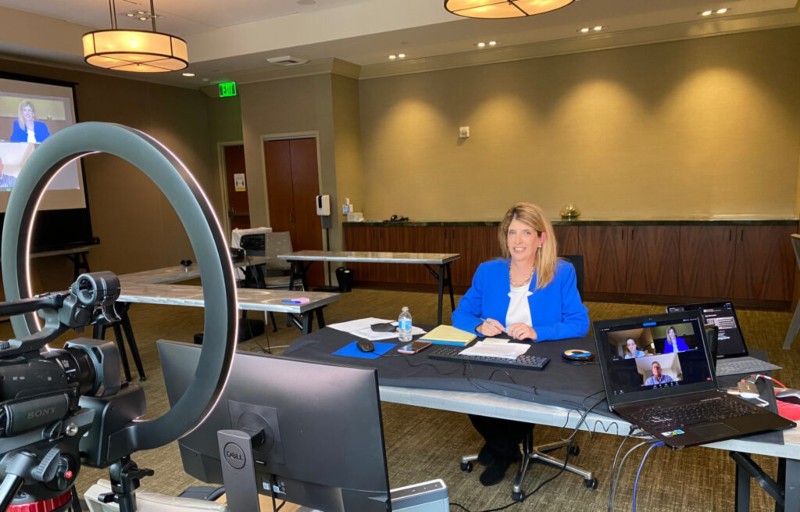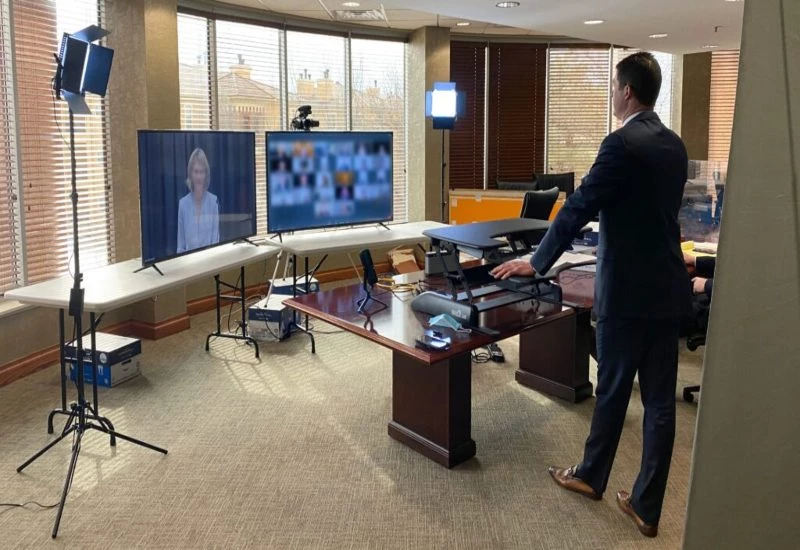When considering your team’s technological capabilities and needs as your virtual (or hybrid) trial approaches, it’s critical to understand how that proceeding is going to vary from what you’re used to. Though you, the judge, and the jurors are now very familiar with videoconferencing, a Zoom trial can be unfamiliar and overwhelming—even for those who consider themselves tech-savvy.
IMS trial presentation consultants have assisted clients with numerous remote proceedings during the COVID-19 pandemic and have a firm grasp on how virtual trials function. We also have the advantage of having leveraged streaming and videoconference software in courtroom applications since the early 2000s.
Through this experience, we’ve identified 18 key points to help you navigate your next Zoom trial. Of course, all jurisdictions are different, and there will be certain minutiae that counsel will need to take into consideration given the timing and venue of the remote proceeding. But, overall, these are the common factors to consider when planning for virtual trials.

Graphic courtesy of IMS Senior Graphic Designer John Ilg
What to Expect from a Zoom Trial
Initial Decisions & Logistics
- Format: Court and counsel will decide on the format of the trial—that is, the extent to which the trial will take place virtually. A fully virtual trial consists of all parties, counsel, court, and jury participating remotely. Hybrid trials typically start with a remote jury selection followed by an in-person trial once openings commence; some or all witnesses may participate remotely.
- Platform: Counsel will familiarize themselves with the Zoom for Government (ZoomGov.com) platform, as well as the platform the court uses for submitting exhibits (such as Box.com, among others). The court will provide links and access information to counsel, witnesses, etc.
- Remote location(s): Health is certainly a priority planning your Zoom trial, but ideally, counsel is able to set up the majority of their team in one location (while adhering to CDC guidelines). For example, if you can utilize your offices as the virtual set, choose one office or small conference room as the presenting room and use a larger conference room for other counsel and team members to observe the proceedings. If any key witnesses are attending with counsel, select a third room for their testimony.
- Bandwidth: Counsel will confirm that they meet the minimum technology and internet bandwidth requirements—as provided by the court—to participate remotely. Minimum speeds tend to be around 10 Mbps; optimal speeds are around 50 Mbps.
- “Zoom Studio” setup: To maximize the ease of presenting, appear at your most professional, and limit potential technical issues, consider setting up a more formal “Zoom studio” in your chosen location. This includes determining your optimal lighting, AV equipment, and camera positioning.
During the Zoom Trial
- Formal attire: Participants in a remote trial should dress in the same manner they would if they were joining in person. When we present virtually from home, we tend to have a more relaxed feeling. Dress professionally from head to toe—even if your feet won’t be on camera.
- Entering the courtroom: Each day, participants will enter a virtual “waiting room” and will be admitted into the virtual “courtroom” when appropriate. Counsel is responsible for notifying witnesses when and how they are expected to report to the virtual waiting room.
- Presenting your case: The optimal setup for presenting your case is to stand during opening and closing and sit during direct and cross. You’ll want either a table-top podium or a banker box to hold your notebook or computer at eye level while standing.
- Objections: Interrupting or speaking over a witness or fellow counsel happens in person, but it’s especially difficult to avoid over Zoom due to the minor lag time. One solution is to address this reality in your pre-trial conference with the court and agree on physically raising your hand when objecting. Further, advise your witnesses to pause a moment before answering questions, so they don’t risk missing a sudden objection.
- Exhibits: All exhibits will be numbered and uploaded to the court’s online repository at the end of each day of testimony.
- Non-presenter etiquette: Non-presenting counsel and support staff must mute their microphones and deactivate their cameras unless instructed otherwise by the court.
Other Technical Considerations
- Zoom screen name: Make sure your screen name is set to your first and last name rather than something confusing or unprofessional (like an email alias or social media handle).
- Mic feedback: Active participants using multiple devices in close quarters—like a single office—should avoid feedback issues by using headphones or utilizing the mic/speakers on a single device at a time.
- Annotations: Decide how you’ll annotate the documents you present on screen. Will you use the Zoom for Government tools? Will your hot seat operator handle it?
- Practice run: Do a full rehearsal of jury selection and your trial presentation. Even if you’ve taken part in hundreds of trials, it’s just not the same over Zoom. Performing a mock virtual jury selection can be a helpful tool to get a feel for how the virtual experience will be similar and different from in-person proceedings.
- Team communications: Counsel should have a secondary platform for the trial team to communicate privately, whether it be text message, Microsoft Teams chat, Google Hangouts, etc. Be mindful not to overuse the platform—and move side conversations to another channel—to avoid overwhelming the presenting attorney with messages.
- Tech check: Counsel should perform a “tech check” in advance of meeting with the court via Zoom to test internet speed, lighting, camera angle, audio, etc. This applies to your witnesses’ setups too.
- Tech troubles: Always be prepared to troubleshoot tech problems on the day of. They happen—have a plan. Having a trained presentation technology expert on hand is a great way to ensure your team can focus on the proceeding itself.

Succeed in Your Zoom Trial
Your focus should be making your best case rather than worrying about the technical elements. Use the guidelines above to prevent unwelcome surprises and provide a foundation for preparing yourselves, your witnesses, and your offices for a Zoom trial. Whether it’s a fully remote proceeding or a hybrid trial with virtual jury selection, these key factors will help position you for success in any online setting.
IMS TrialLink® Virtual Support Services
IMS virtual technology consultants can set up and operate a temporary Zoom studio at your location. We supply broadcast-quality equipment, carefully test each element, and employ a redundant setup for instant switching to a backup system in the event of a technical issue. During presentations, we assume the role of technical director and hot seat operator to switch between cameras, presenters, documents, testimony, exhibits, and slides on cue.
Learn more about how IMS can help with your next Zoom trial.







